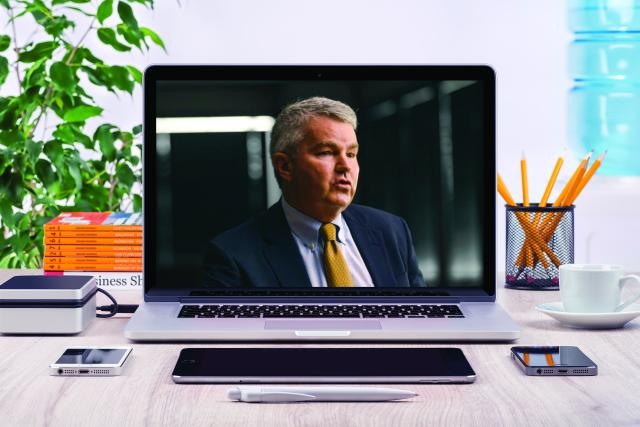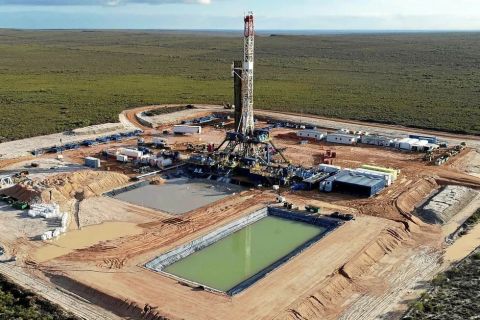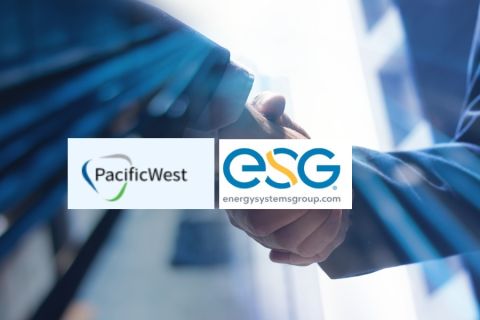
NOV CEO Clay Williams discusses the future of onshore and offshore oil and gas development, the impact of the energy transition on oilfield service providers and more amid the challenging energy climate.
[Editor's note: A version of this story appears in the October 2020 issue of Oil and Gas Investor magazine. Subscribe to the magazine here.]
Amid the continued presence of COVID-19 and distressed market conditions, the question of transformation is on the oil and gas industry’s mind now more than ever. What will the future of oil and gas look like, what will remain the same and what will need to change? National Oilwell Varco (NOV) is at the fore of answering this question in the oilfield service sector.
As one of the leading global providers of onshore and offshore equipment and technology, the firm continues to invest in new technologies and seek forward-looking solutions to industry challenges, according to Clay Williams, chairman, president and CEO of NOV.
Williams recently provided an exclusive video interview in which he shared his views on the way forward for oilfield service companies. The following is a transcription of that interview, edited for style and clarity.
What does an oilfield service company look like to you in the future? How is your company positioned to make that shift?
One of the challenges we’ve been facing in oilfield services has been the rising cost of capital, because our financial performance has not been very good through the past several years of the downturn.
Plus, you’ve got this narrative of pivoting away from oil and gas, peak oil demand, and a lower carbon world, which makes it hard for the providers of capital to invest in our industry. And that’s important because we have a very capital-intensive industry.
Going forward, our industry is going to have to put up better financial returns, but above all, we’re going to make sure that we’re adding value to the operations of oil and gas companies because they’re facing similar challenges, and if the value that we bring to their operations isn’t tangible and demonstrable, they can’t afford to pay for it. All of us across oil and gas are going to have to head to a world where we’re more efficient and better at what we do.
Where do you see offshore and shale fitting in this new energy world?
You know, oil and gas are such critical commodities to global economies, to our standards of living. Before the COVID-19 downturn, we reached 100 million barrels a day of demand. Frankly, we need oil from all sources; we need it from unconventional shales; we need it from the offshore; we need it from conventional sources globally. I think the future is going to be characterized by oil coming from a diverse base of supply, and I think that’s necessary to make sure that the world continues to be supplied with affordable energy.
How is your company helping deliver shale technologies to new plays outside of the U.S.?
Unconventional shales grew global production by 5 million barrels a day in just a few short years, so we find our customers, national oil companies and global international oil companies watching very intently what’s going on in the unconventional shale world, perhaps with a little bit of trepidation.
But as they’ve realized that this is a very impactful technology and it’s really reshaping the supply of oil globally, many recognize it’s an opportunity to deploy these technologies in their own basins. In places like Argentina with the Vaca Muerta Formation, Saudi Arabia with unconventional gas drilling, China, we’re seeing greater demand for directional drilling technologies that deliver horizontal wellbores along with demand for hydraulic fracture technologies, and these are really two enabling technologies that make unconventional work.
How do you see E&Ps evolving in the offshore to drive better returns?
Offshore has not stood still through the downturn either. Unconventionals did a great job dropping their costs and seeing continued rising production through the downturn. But there’s an awful lot of smart people working in offshore as well, and it’s a big prize in the offshore with the reserves that have been discovered in deepwater and other places.
Through advancements in subsea lifting and separation in offshore structures, FPSOs, flexible pipe, the processing and separation units, we’ve reduced the weight and the cost of these things. Those technical advancements coupled with deflation in drilling, improvements in drilling efficiencies as drilling has continually gotten better and better through the downturn, along with deflation and other services required to develop offshore fields have dramatically improved their cost positioning.
And I would add that this industry is made up of really, really smart people who love a good challenge, and the past six years have been nothing if not a good challenge.
What you’ve seen is the oilfield practicality in action. Very clever, innovative designs, the application of technologies, including some digital technologies, have continued to reduce the cost of offshore barrels, and I’m confident that trend's going to continue into the future.
Nevertheless, the oil and gas industry has a reputation for being a slow adopter of new technology and of running behind on the adoption of digital technologies. How do you see the current downturn impacting technology adoption?
I’ve got to tell you, I bristle a little bit when I hear that the oil and gas industry doesn’t understand digitalization. We were the first big data industry; most of the Cray computers that were built in the 1970s and 1980s were built specifically to handle the enormous digital data sets that came out of geophysical shoots that supported the oil and gas industry. What I would submit is that, actually, the oil and gas industry is very, very experienced and realistic when it comes to dealing with data and with digital technologies, meaning we understand the practical limits and the challenges that we face when you deploy digital technology.
Specifically data cleanliness, competing protocols, formatting, the maintenance of connectivity in the remote places where we work, the problem of garbage in, garbage out—these are things that I began to deal with on my first day as a young engineer in this industry in the 1980s. Our generation, I think, is very familiar with not just the promise of digital, but most importantly, the limitations and the practical challenges that we face as we deploy digital solutions.
Nevertheless, I don’t want to give you the wrong impression. I think digital technologies will continue to evolve. We’ve seen a dramatic reduction in the cost of the storage of data, dramatic improvements in the transmission and the collection of data, and the processing speeds with which we manipulate data, and that all extends the boundaries and the possibility of digital solutions.
I think it’s incumbent on all of us to stay abreast of those developments, to make sure we’re deploying digital solutions to improve our business along the way.
I’ll give you a good example. For instance, we, through the downturn, used augmented-reality technology and remote monitoring with our TrackerVision™ system to enable our customers to perform factory acceptance testing on equipment prior to delivery. This is something that previously was always done in person. Our customers would come to our factories and accept equipment, but augmented-reality technologies has enabled a new way of doing that.
With more people working remotely it appears the opportunities are growing for digital systems. Where does digital go from here?
It’s really up to us as providers of these things to develop solutions that help them navigate these challenges and don't overpromise and underdeliver.
I’m very proud to say that NOV has a great track record in this area. For over 20 years, for instance, our eHawk™ system has monitored networks on offshore drilling rigs, a couple hundred offshore drilling rigs, and helped us help our customers manage their networks. Our Martin-Decker Totco product line for 80-plus years has been the leading provider of rig instrumentation systems, meaning the rig dashboard, the electronic drill recorders that act as data historians on hundreds of rigs globally. We have the only high-speed data transmission capability to the bottom of the hole with our IntelliServ™ network that transmits data at 55,000 bits per second.
In 2016, we introduced the industry’s first commercial predictive analytics product that monitors subsea BOPs. We recognized in the data we could see a potential SPM valve failure 14 days before the valve actually failed. We began offering this predictive analytics service, and since then have expanded it from subsea BOPs to surface drilling equipment and now offer dozens of potential failure modes that we can predict in advance. These are all great examples of where we’ve applied digital technologies to improve our operations, the operations of our customers.
What new digital technologies has NOV focused on to drive better operations? Which of these are you most excited about?
We’ve continued to invest through the downturn despite having to cut costs. In October, for instance, we’re going to be commercializing a new data platform that I’m very excited about called NOV MAX™, which is basically edge technology that we’ve been working on for about three years. It takes the challenges of data management that I mentioned earlier head on. What that means is, military grade encryption, up to 12 kilohertz data density, full disaster recovery, including the necessary ISO 27001 certifications, universal translator, so we can accept over 30 protocols of data.
We can output over 15 different types of protocols of data, depending on what our customer wants, and put that data out to their cloud, to our cloud, to our portal for our customers to access to their office. Think, oilfield Netflix, and our role in that is to be a custodian of their data, to work through the tedious processes of cleaning it. It’s built on ruggedized hardware. It’s edge hardware that can run their proprietary applications in the field or third-party apps or our own apps.
In addition to that, we’ve had great success with our operating system for drilling rigs, a system we call NOVOS™. We've sold about 160 rigs thus far, and so it’s being used now widely across certain customers’ operations, and they’re getting great results with it. Later this year we’re going to be introducing hardware that works with that software foundation, and the hardware will enable drilling automation, true drilling automation, which has been a goal of this industry for decades. And, importantly, we’re going to launch this hardware upgrade for rigs that’s very, very affordable and will fit well the NOVOS digital foundation we’ve been laying to put in place automation.
These are just two examples of things that we’ve been working on through the downturn, and I’m very pleased to say we’ve got many, many others across the organization as well.
There are many E&Ps and service companies struggling, looking for a new strategy in today’s environment. What would you say differentiates your company from others?
I think NOV is a little bit unique in the oilfield ecosystem in that we’re mostly an equipment provider. Most of our revenues come from providing equipment and spare parts and services to other oilfield service companies. So, in many ways, we’re sort of a second derivative from E&P spending in the space.
What that means is we have a very large install base across numerous categories of equipment, and it’s an install base that lends itself to digital solutions, efficiency enhancements and better care and feeding with respect to the maintenance and service and repair of that equipment. We’ve been very focused on that as well.
Climate change remains a dominant topic of conversation and a concern. In building a new energy system that is renewable or more sustainable, how do you see the oil and gas industry contributing to this effort?
First and foremost, I think climate change and the pivot to new sources of energy is an enormous opportunity for all industries and all businesses. And I think oilfield services in particular is well-placed to capitalize on that. If you look at what’s required in energy, energy is really all about infrastructure and capital investment. And if you look back at energy transitions through the centuries, it’s been gated by the fixed base and installed base of equipment and machines and infrastructure that provide that energy and use that energy for the benefit of consumers. That doesn’t turn on a dime, but when it does turn, it requires a lot of project management expertise, a lot of capital formation expertise, and it calls for the application of technology. These are things that we do very well in oilfield services.
I think our industry can and will play a big role in that transition, and in our own company we’ve been making very targeted investments in this area for the past several years, and we’re pretty excited about what the future holds.
What is your outlook for the year ahead, and what do you see as the greatest challenge? What about five years from now?
Unfortunately, the severity of this downturn may well be the worst this industry has ever seen, dating back to the 19th century. We’re in a place that the industry hasn’t been before, and I would love to tell you that I think it’s going to turn around quickly, but realistically I don’t [think that]. I think we’re in for the next year or two of continued necessary restructuring and doing the painful things around cost reductions that are required for us to do.
However, I do think the world has set itself up for a potential turnaround quickly in commodity prices. The evaporation of spending and activity in our industry of oil-and-gascompany capital expenditures, of new drilling, and so forth, there’s always a price to pay with that, number one. Number two, with a billion barrels or more of excess storage and inventory, demand has to exceed supply for a meaningful amount of time before that billion barrels of excess inventory can flow back into the market and be burned off to get back to a normal place.
And any time this industry gets in a position where supply is insufficient to equal demand, the world potentially has a problem. That problem being potentially masked for a period of time while the excess inventory burns off, I think may well be the foundation for commodity price shock in the future. So this industry, I think in the next five years, not in the next year or two, but in the next five years, is very likely to be asked to step up very, very quickly and grow production as quickly as possible to put supply and demand back in balance.
It’s a really fascinating time for the armchair student of the industry, which I sometimes consider myself to be. It’s a fascinating time with respect to this industry.
What advice do you have for young professionals in this industry as we navigate this downturn?
I understand that it looks very challenging and some might even say bleak right now. I would tell you, you’re part of a great critical industry that has made the world better, that has lifted many, many [people] out of poverty. In fact, I believe that no other industry has done more to lift standards of living of mankind than the oil and gas industry.
The other day I was standing in my driveway, and I made an important observation about my automobile, which I rely on pretty heavily—it runs on gasoline, a product of our industry, as does my wife’s, as do my kids’, as do all of the cars driving around Houston, save for a few Teslas that I see every day, as do essentially all of the automobiles on the planet. Nearly 100% of automobiles require our product to go. 100% of aircraft require our product to go. 100% of the tractor-trailer rigs that deliver all the Amazon packages to my house require our product to go. 100% of construction equipment that build buildings, that maintain roads, rely on our product. 100% of tractors and combines that produce the food that feed the planet run on our product. This is a critical product.
You think about all those categories of equipment. How many tens of trillions of dollars are invested in that capital infrastructure globally? And guess what, none of it goes without oil and gas. Oil and gas, our customers, and the owners of that equipment rely on you and me to deliver oil and gas efficiently, and safely, and cost effectively so that all that capital equipment can run.
This industry is going to be around a long time. It won’t be around forever. And I do think that we will pivot to lower carbon sources of energy, but I think you and I have a role to play in that as well, as I mentioned earlier. And I think that’s a great opportunity for all of us.
So, it’s a tough industry, it’s not for the faint of heart. When things cycle down, it looks very bleak. What I’m most grateful for today in 2020, frankly, is having lived through some of these down cycles and having lived through to the other side. And what I would tell you is there’s always another side, and there will be this time around, too. We’re going to see prosperity return. We’re going to get busy again. I would tell you to hang in there. This is going to get better, and you’ll look back at this time and realize that you probably grew more through the downturn than you may fully appreciate right now. When I look back on my own career, I credit the downturns and the tough times that I went through for really making me who I am.
Recommended Reading
Brett: Oil M&A Outlook is Strong, Even With Bifurcation in Valuations
2024-04-18 - Valuations across major basins are experiencing a very divergent bifurcation as value rushes back toward high-quality undeveloped properties.
Marketed: BKV Chelsea 214 Well Package in Marcellus Shale
2024-04-18 - BKV Chelsea has retained EnergyNet for the sale of a 214 non-operated well package in Bradford, Lycoming, Sullivan, Susquehanna, Tioga and Wyoming counties, Pennsylvania.
Triangle Energy, JV Set to Drill in North Perth Basin
2024-04-18 - The Booth-1 prospect is planned to be the first well in the joint venture’s —Triangle Energy, Strike Energy and New Zealand Oil and Gas — upcoming drilling campaign.
PGS, TGS Merger Clears Norwegian Authorities, UK Still Reviewing
2024-04-17 - Energy data companies PGS and TGS said their merger has received approval by Norwegian authorities and remains under review by the U.K. Competition Market Authority.
Energy Systems Group, PacificWest Solutions to Merge
2024-04-17 - Energy Systems Group and PacificWest Solutions are expanding their infrastructure and energy services offerings with the merger of the two companies.




